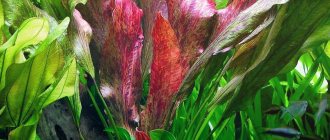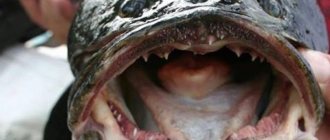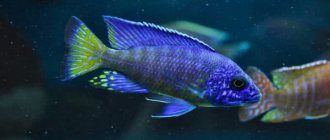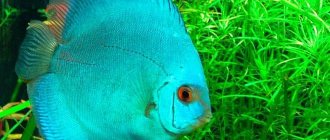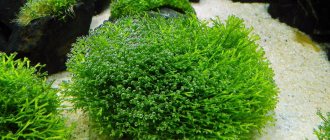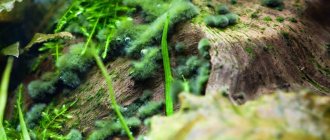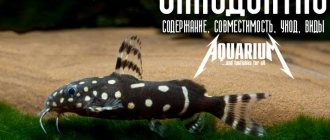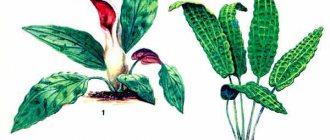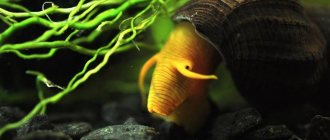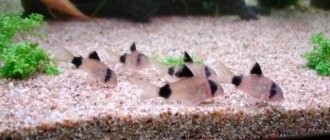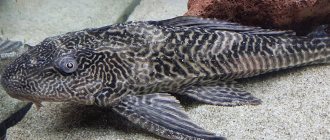When decorating the interior of an aquarium, the main goal is to make it not just beautiful, but useful for the inhabitants, so that it is as close as possible to the natural biotype. For health and long existence, aquatic inhabitants need a large amount of greenery around them, as it serves as a guarantee of protection and provides oxygen in the water.
Higher spore-bearing bryophyte plants, or mosses, are considered an ideal option for an aquarium; they do not require complex care, have an attractive appearance and are resistant to an aggressive external environment.
Aquariums are a field of human activity that is in continuous development, so new species not only of fish, but, in particular, of mosses are appearing. These plants are ideal for the built environment. To choose the right aquarium mosses, you need to know what types of mosses exist, as well as all the conditions for each species.
Benefits of using mosses
Aquarium moss adapts to any habitat and is easy to care for. Experts classified them as unpretentious plants in the aquarium. It does not matter the strength of the lighting or whether it is there; fertilizers are not needed, since plants receive all substances important for life from the external environment, absorbing them from the surface. The created composition will not change its original appearance, since mosses take a long time to grow. They reproduce by spores - in place of some, others appear, mosses grow even on stones or snags. The benefits of using mosses are many:
- No care is required and they adapt to many conditions.
- Slow growth.
- They create a natural look for the interior of the aquarium.
- Can be used in an aquarium of any size and volume.
- They do not have roots in the soil, so they can be transported with the substrate.
- They provide safety for fry and are an ideal place for spawning.
Due to its significant positive characteristics, moss has become actively used in aquarium design.
Moss in an aquarium
Caring for an aquarium with mosses
Recommended water parameters for moss content: water hardness KH=1-4, gH=5-10, pH=6.3-6.7. However, mosses adapt well to less ideal water conditions. Our aquarium has the following water parameters: water KH=6, gH=8, pH=7.2.
A very important point in caring for moss grass is correct water changes. As with any herbalist aquariums, it is recommended to change the water once a week in 1/4-1/2 part. The issue of changing water is individual; after starting, you need to look at what the tests say and visually assess the “health of the aquarium.” In our aquarium we did small water changes of 1/4 - 1/3, but twice a week.
Routine care for mosses is simple. As they grow, they are cut and shaped. A good pruning makes mosses more luxuriant and branchy.
Conditions for breeding
These breeding conditions are mandatory regardless of what species are used for decoration; mosses require approximately the same temperature conditions.
- The ideal temperature for maintaining the created composition of spore plants is from 20 to 25 °C.
- It is important to add nitrates and phosphates only when absolutely necessary.
- Keep the inside of the aquarium clean and periodically remove all accumulated debris.
- When growing plants, new branches must be removed, otherwise the moss that has grown on them will contribute to the death of the lower branches.
- There must be aquarium soil, as it plays an important role for all plants and inhabitants, as well as mosses, being a “natural filter” that cannot be replaced by anything.
How to attach and tie aquarium mosses?
The process of decorating an aquarium with mosses is quite labor-intensive. You need especially a lot of patience if you are planning to recreate an aquascape in the “Deep Forest” style and you need to use a large amount of moss to realize the idea.
All mosses that “cling” well to the surface can be attached with threads; while the threads rot, the moss will have time to cling. Mosses that do not attach well are fixed with fishing line. Before you start decorating an aquarium with mosses, you must: carefully think through the composition, prepare scissors, a knife, a spray bottle, black threads, fishing line, super glue.
Video about attaching moss at a master class by Takashi Amano
track time 10:40
You can absolutely safely attach the moss using super glue. Glue is very helpful when you need to attach moss in a non-standard way or in a specific place where this cannot be done with threads and fishing line. In addition, you can work with glue even in water, making the final touches.
While working, do not forget to moisturize - spray the already attached mosses with a spray bottle. Distribute the mosses themselves over the surface evenly and carefully, try not to allow excessive layering of moss branches on top of each other.
Conclusion
Let's once again focus on the most important aspects that are necessary to create a lush aquarium with mosses:
1. Ideal biological balance. In particular, the tuned nitrogen cycle is NH4-0, NO2-0, NO3-10.
2. Proper lighting (approximately 0.5 Watt per liter or 30-40 Lumens per liter).
3. Proper water changes.
4. High-quality and correct water filtration.
5. Fertilizers: CO2, micro and macro are optional. But when properly applied, the mosses “fluff up.”
6. Correctly selected hydrobionts. Aquarium shrimp are the best friends of any shrimp fisherman! No American cichlids, goldfish or even algae eaters should be in an aquarium with mosses. Neons and tetras look great in mosses. You can also use viviparous fish (swordtails, platies, mollinies), but keep in mind that they may nibble the moss slightly.
Cool videos about plants and herbalism from FanFishki
Subscribe to our YouTube channel so you don't miss anything
Types of mosses
Stores offer a wide range of plants for artificially created ponds. Moss for an aquarium is divided into different classes, depending on its appearance and habitat. Experts, having carried out a series of studies, have identified the following varieties of mosses:
- anthocerotes;
- liverworts;
- deciduous.
The first species is distinguished by its blade-like leaves and is distributed in tropical environments and temperate climate zones. A rare species, used for decorating aquariums.
Liverwort is the most popular spore-bearing plant used for compositions. It is small in size and very tender. More often, aquarists use “Riccia floating”; it is ideal for home ponds. The leafy species is also used for decoration; it is divided into three subclasses:
- andreaceae;
- shaving;
- sphagnum
This species is the most numerous, and therefore was divided into varieties. Previously, such a number of spores was not known. In addition to Riccia, specialists used fontinalis and Java moss, however, they were planted only in spawning areas.
In addition to the above-mentioned species, aquarists also actively use the following:
- Key moss.
- Weeping moss.
- Christmas moss.
- Leptodiccium coastal.
- Lomariopsis lineatu.
- Monosilenium tenerum.
What to consider when choosing plants
It is important to provide your aquarium plants with proper care.
Therefore, you need to be responsible when choosing flora. What factors to pay attention to:
- aquarium project . It is better to think in advance what the composition will look like and select mosses specifically for it;
- personal experience . If there is not much of it, it is better to first choose the most unpretentious specimens;
- aquarium parameters . Some types of mosses grow very tall, so they will not be comfortable in a small tank.
Moss garden lighting
Sufficient lighting is an important factor in moss maintenance. Even if the sun's rays enter the aquarium, you still need to provide artificial lighting. Phyto-lamps are suitable. For example, an LED model with Osram Oslon LEDs, compact Aquael LEDDY SLIM PLANT 5W, ADA AQUASKY 602, Aqua-Medic Qube 50 Plant.
When choosing a lamp, pay attention to the spectrum, lamp power and color rendering level. Make sure that the streams illuminate the aquarium evenly. Also pay attention to the type of mounting of the lamp. The average lighting parameter is 30-40 Lm/liter of water. You should rely on the volume, depth and shape of the tank.
The length of daylight hours depends on the inhabitants of the aquarium. The average is 6-10 hours. It is better to avoid excessively powerful and prolonged lighting to avoid an algae outbreak.
Designer finds
Proper design of the aquarium helps to achieve a stunning visual effect. Javanese can be used to decorate the back wall of an aquarium.
- To do this you will need to measure the area of the wall.
- Then you need to select a plastic mesh of the same size. Before use, rinse the mesh thoroughly with water.
- Java moss is attached over the entire area of the mesh using synthetic thread or thin fishing line.
- Suction cups are placed on all corners of the mesh, with the help of which it is installed on the wall of the aquarium.
- The mesh is carefully lowered into the water and attached to the wall of the aquarium using suction cups.
Although the back wall of the aquarium is often chosen for decoration, you can decorate any wall with moss by placing it under a tightly secured mesh.
For the second decoration method you will need a coconut.
- It is necessary to break off the top of the nut and pour out the coconut juice.
- Divide the coconut into two parts and remove the pulp from each of them.
- Next, cook the peeled half in boiling water for half an hour.
- Let the coconut cool and drill a few holes in the shell using a drill.
- Secure the Javan with synthetic thread or fishing line and place the half in the aquarium.
Coconut will not only be an excellent element of aquarium decor, but also a home for fish!
Description
This aquarium plant is a clump of intertwined branching stems that are densely covered with small leaves. The stem length is about 17 cm. It is soft and branched. The sheet size does not exceed 4 mm. They grow on a stem opposite each other. Young leaves are colored light green. Old sheets have a darker, green color. The base of the Javanese has many rhizoids, with the help of which it is attached to hard surfaces. Rhizoids play the role of the root system.
Bryophyte grows in a vertical as well as a horizontal position.
Aquarists use it not only as a decorative decoration. Thickets of Java moss are a good substrate for the spawning of many types of aquarium fish. Thanks to its sponge-like shape, the Javan becomes a hiding place for the eggs. The eggs fall between the stems and are harder for adult fish to find and eat. The fry get a chance to hatch and continue their development. The moss contains many ciliates, which are the main food for growing fry. Java moss is a natural filter. It purifies water from harmful impurities and other debris.
